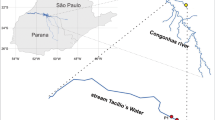Abstract
Studies were carried out in eight woodland water bodies that are situated in an urbanised area of Southern Poland (Upper Silesia). The aim of this study was to determine the influence of auto- and allochthonous plant detritus and exposure to sunlight on the structure of snail communities in woodland ponds. Among some physico-chemical water parameters, pH influenced the occurrence of snails, whereas sunlight caused an increase in diversity of the snail communities. In the total snail collection, 72.1% of specimens were gathered in sun-exposed sites. By the same degree of insolation more preferred by snails were the sites with allochthonic detritus. The snail fauna of subsidence ponds located inside a forest area differs from those occurring in urban agglomerations. The most conspicuous difference is the high numbers in three woodland ponds of Hippeutis complanatus (L.), which is rare in this area.
Similar content being viewed by others
References
Aho J. 1966. Ecological basis of the distribution of littoral freshwater molluscs in the vicinity of Tampere (South Finland). Ann. Zool. Fenn. 3: 287–322.
Allan J.D. 1998. Ekologia wód płynących. PWN, Warszawa, 451 pp.
Banfield E.F. 2006. Decomposition of leaf material, pp. 711–720. In: Hauer F.R. & Lamberti G.A. (eds), Methods in Stream Ecology, Elsevier, Amsterdam.
Batzer D.P., Dietz-Brantley S.E., Taylor B.E. & Debiase A.E. 2005. Evaluating regional differences in macroinvertebrate communities from forested depressional wetlands across eastern and central North America. J. N. Am. Benthol. Soc. 24: 403–414.
Bonner L.A., Walter J.D. & Altig R. 1997. Physical, chemical and biological dynamics of five temporary dystrophic forest pools in central Mississippi. Hydrobiologia 353: 77–89. DOI 10.1023/A.1003098526340
Dillon R.T. 2000. The Ecology of Freshwater Molluscs. Cambridge University Press, 509 pp.
Dussart G.B.J. 1976. The ecology of freshwater molluscs in northwest England in relation to water chemistry. J. Moll. Stud. 42: 181–198.
France R.L. 1995. Macroinvertebrate standing crop in littoral regions of allochthonous detritus accumulation: implications for forest management. Biol. Conserv. 71: 35–39. DOI 10.1016/0006-3207(94)00018-L
Gasith A. & Ławacz W. 1976. Breakdown of leaf litter in the littoral zone of a eutrophic lake. Ekol. Pol. 24: 421–430.
Glöer P. 2002. Süsswasser Gastropoden Nord und Mitteleuropas. Conch Books, Hackenheim, 327 pp.
Hermanowicz W., Dojlido J., Dożańska W., Kosiorowski B. & Zerze J. 1999. Fizyczno-chemiczne badanie wody i ścieków. Arkady, Warszawa, 566 pp.
Hubendick B. 1947. Die Verbreitungsverhältnisse der limnischen Gastropoden in Südschweden. Zool. Bid. Från Uppsala 24: 419–556.
Kerney M. 1999. Atlas of the Land and Freshwater Molluscs of Britain and Ireland. Harley Brooks, Martins, Great Harhesley, 264 pp.
Lewin I. & Smoliński A. 2006. Rare and vulnerable species in the mollusc communities in the mining subsidence reservoirs of an industrial area (the Katowicka Upland, Upper Silesia, Southern Poland). Limnologica 36: 181–191. DOI 10.1016/j.limno.2006.04.002
Lodge D.M. 1985. Macrophyte — gastropod associations: observations and experiments on macrophyte choice by gastropods. Freshwater Biol. 15: 695–708. DOI 10.1111/j.1365-2427.1985.tb00243.x
Lodge D.M. 1986. Selective grazing on periphyton: a determinant of freshwater gastropod microdistributions. Freshwater Biol. 16: 831–841. DOI 10.1111/j.1365-2427.1986.tb01020.x
Nicolet P., Biggs J., Fox G., Hodson M.J., Reynolds C., Whitfield M. & Williams P. 2004. The wetland plant and macroinvertebrate assemblages of temporary ponds in England and Wales. Biol. Conserv. 120: 261–278. DOI 10.1016/biocon.2004.03.010
Økland J. 1990. Lakes and Snails. Universal Book Services, Oegstgeest, 516 pp.
Pope R.J., Gordon A.M. & Kaushik N.K. 1999. Leaf litter colonisation by invertebrates in the littoral zone of small oligotrophic lake. Hydrobiologia 392: 99–112. DOI 10.1023/A:1003537232319
Salmoiraghi G., Gumiero B., Pasteris A., Prato S., Ponacina C. & Bonomi G. 2001. Breakdown rates and macroinvertebrate colonisation of alder (Alnus glutinosa) leaves in an acid lake (Lake Orta, N Italy), before, during and after liming intervention. J. Limnol. 60: 127–133.
Spyra A. 2008. The septifer form of Ferrissia wautieri (Mirolli, 1960) found for the first time in Poland. Mollusca 26: 95–98.
Spyra A., Serafiński W. & Strzelec M. 2007. The species diversity of freshwater snails (Gastropoda) in differently managed fish ponds in S-W Poland. Ekológia (Bratislava) 26: 83–89.
Strzelec M. 1993. Zbiorniki zapadliskowe jako szczególne środowisko życia ślimaków wodnych w Górnośląskim Okręgu Przemysłowym. Kształt. Środ. Geogr. Ochr. Przyr. Obsz. Uprzemysł. Zurb. 9: 31–36.
Strzelec M. & Serafiński W. 2004. Biologia i ekologia ślimaków w zbiornikach antropogenicznych. Centrum Dziedzictwa Przyrody Górnego Śląska, Katowice, 90 pp.
Strzelec M., Spyra A., Krodkiewska M. & Serafiński W. 2005. The long-term transformations of gastropod communities in dam-reservoirs of Upper Silesia (Southern Poland). Malacol. Bohem. 4: 41–47.
Strzelec M., Spyra A. & Serafiński W. 2006. Over thirty years of Physella acuta (Draparnaud, 1805) expansion in the upper Silesia and adjacent regions (Southern Poland). Malakol. Abh. 24: 49–55.
Author information
Authors and Affiliations
Rights and permissions
About this article
Cite this article
Spyra, A. Environmental factors influencing the occurrence of freshwater snails in woodland water bodies. Biologia 65, 697–703 (2010). https://doi.org/10.2478/s11756-010-0063-1
Received:
Accepted:
Published:
Issue Date:
DOI: https://doi.org/10.2478/s11756-010-0063-1




